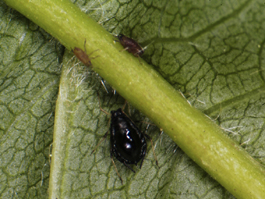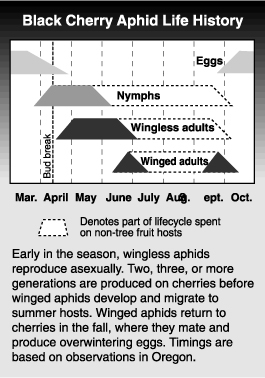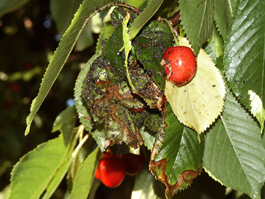by Lynn Long and Helmut Riedl, originally published 1993; revised online December 2007
Myzus cerasi (Fabricius) (Homoptera: Aphididae)

The black cherry aphid is found wherever cherries are grown throughout the United States. It infests leaves and deposits honeydew on leaves and fruit. Heavy populations can deform shoots, stunting young trees. Although not a serious pest under conventional orchard management programs, it has arisen as a more serious problem in organic orchards. It can also be a problem in young orchards and nurseries if populations are not properly controlled.
Hosts
The aphid prefers sweet cherry but will also attack tart cherries. On tart cherry it does not curl the leaves as it does on sweet cherries. Cherry is its winter host. In summer, it migrates to plants of the mustard family.
Life stages
Egg
The egg is small and shiny black.
Nymph
The nymph ranges in color from amber through various shades of dark brown to black
Adult
Both winged and wingless adults are shiny dark brown to black . They have a round abdomen and globular appearance. The black cherry aphid is larger than other fruit attacking aphids and is the only black colored aphid that attacks cherry.
Life history
 The insect overwinters in the egg stage. Eggs are laid on the bark or buds of twigs and hatch before the buds open in late March or early April. The young aphids feed on unopened buds in the early spring. After bud break they attack the leaves. The leaves curl and protect the aphids as they continue feeding. Aphids mature within 2 or 3 weeks of hatching and begin to reproduce asexually. Two, three or more generations can be produced on cherry. The later generations often mature in less than a week. In each generation some winged adults are formed, which migrate to plants of the mustard family.
The insect overwinters in the egg stage. Eggs are laid on the bark or buds of twigs and hatch before the buds open in late March or early April. The young aphids feed on unopened buds in the early spring. After bud break they attack the leaves. The leaves curl and protect the aphids as they continue feeding. Aphids mature within 2 or 3 weeks of hatching and begin to reproduce asexually. Two, three or more generations can be produced on cherry. The later generations often mature in less than a week. In each generation some winged adults are formed, which migrate to plants of the mustard family.
By early to midsummer few, if any, aphids remain on cherry. Succeeding generations occur on the summer host. In the fall, winged males and females fly back to the cherry where they mate and produce eggs that overwinter on the bark.
Damage
Large numbers of black cherry aphids will colonize young terminal growth. Infested leaves curl severely and normal terminal growth is disrupted. In severe cases, injured leaves turn brown and die and the fruit is dwarfed. The aphids excrete large amounts of honeydew on leaves and fruit.
Sooty mold can grow on the honeydew, making the fruit unmarketable. Heavy populations can distort and stunt growth of young trees and may reduce fruit set the following year on older trees.

Monitoring
It is important to monitor for black cherry aphid during and shortly after bud break. Management decisions should be made at this time, as the insect is more easily controlled when small and exposed. Once leaves curl, the aphid is more difficult to reach with insecticides.
Biological control
Lacewing larvae, lady beetles, syrphid flies, soldier beetles and predacious midges are among the predators that help keep populations of this aphid under control.
Management
Delayed-dormant applications of oil mixed with an insecticide applied to control other cherry pests will usually control the black cherry aphid. No criteria have been developed on what degree of infestation will cause significant economic loss. After the leaves curl it is difficult to achieve chemical control and sprays may disrupt predators.